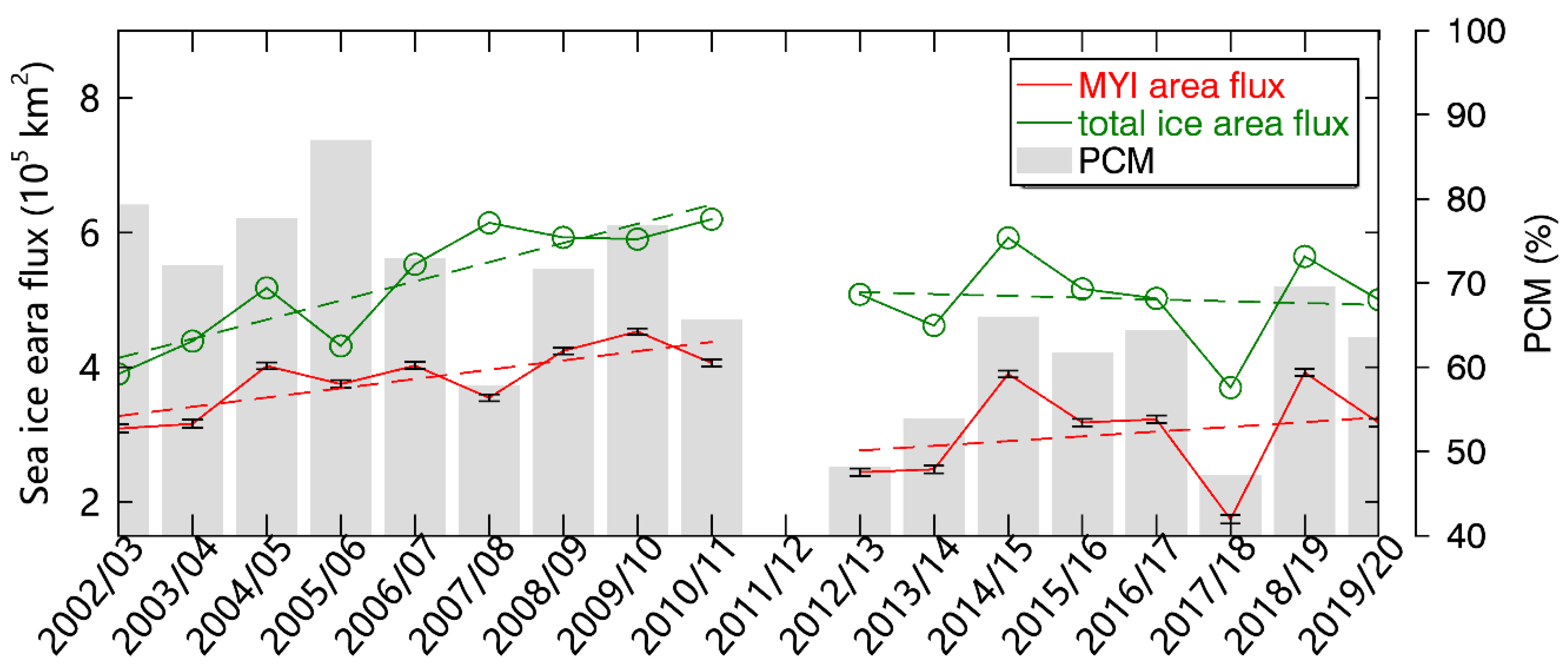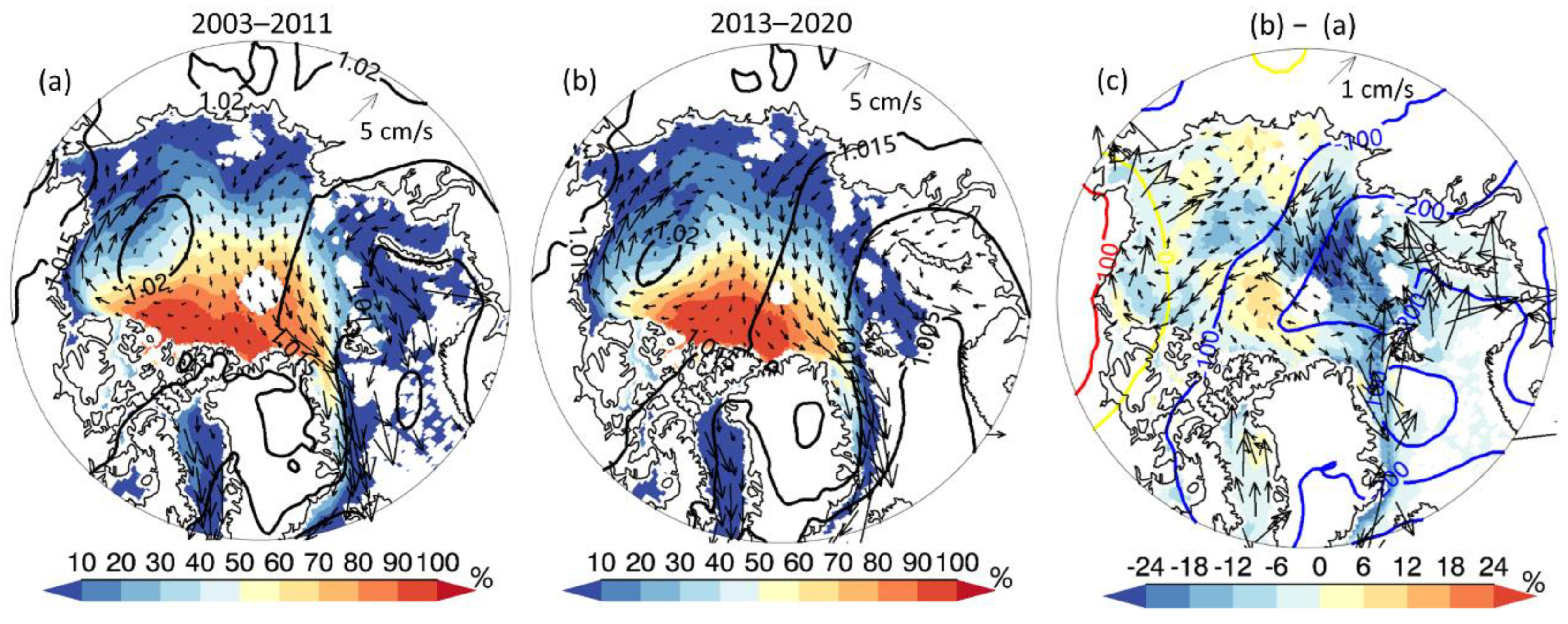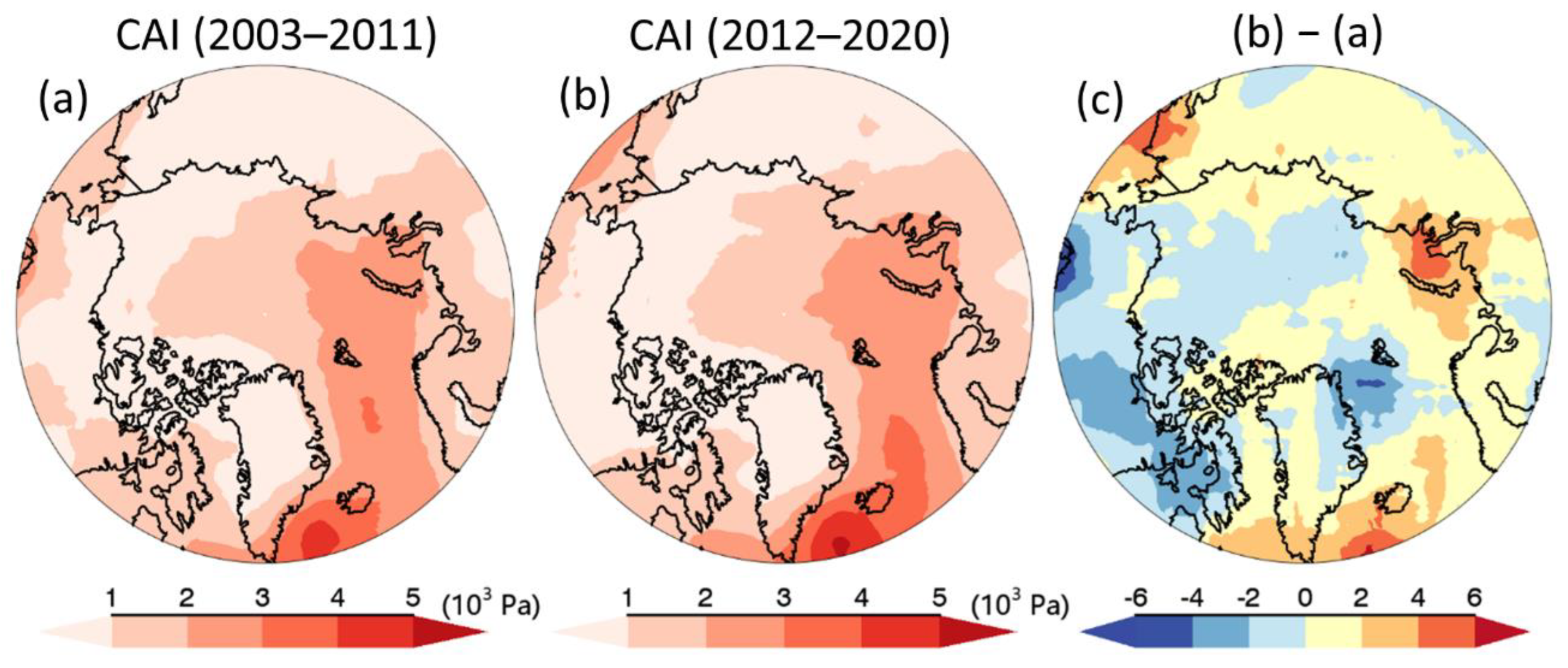A Satellite-Observed Substantial Decrease in Multiyear Ice Area Export through the Fram Strait over the Last Decade
Abstract
:1. Introduction
2. Data and Methodology
2.1. Data
2.2. Methodology
2.2.1. Sea Ice Area Flux Estimates
2.2.2. Uncertainty of Sea Ice Area Flux
2.2.3. MYI Export Index
2.2.4. Cyclone Activity Index
3. Results
3.1. MYI Area Export through the FS
3.2. Seasonal Cycle of MYI Area Export
3.3. Variability in Monthly MYI Area Export
3.4. Influence of MYI Distribution and Motion on MYI Export
4. Discussion
5. Conclusions
Author Contributions
Funding
Data Availability Statement
Conflicts of Interest
References
- Porter, D.F.; Cassano, J.J.; Serreze, M.C. Analysis of the Arctic atmospheric energy budget in WRF: A comparison with reanalyses and satellite observations. J. Geophys. Res. Atmos. 2011, 116, D22108. [Google Scholar] [CrossRef]
- Smith, D.M.; Dunstone, N.J.; Scaife, A.A.; Fiedler, E.K.; Copsey, D.; Hardiman, S.C. Atmospheric response to Arctic and Antarctic sea ice: The importance of ocean–atmosphere coupling and the background state. J. Clim. 2017, 30, 4547–4565. [Google Scholar] [CrossRef]
- Peterson, A.K.; Fer, I.; McPhee, M.G.; Randelhoff, A. Turbulent heat and momentum fluxes in the upper ocean under Arctic sea ice. J. Geophys. Res. Ocean. 2017, 122, 1439–1456. [Google Scholar] [CrossRef]
- Perovich, D.K.; Polashenski, C. Albedo evolution of seasonal Arctic sea ice. Geophys. Res. Lett. 2012, 39, 8501. [Google Scholar] [CrossRef]
- Overland, J.E.; Wang, M. When will the summer Arctic be nearly sea ice free? Geophys. Res. Lett. 2013, 40, 2097–2101. [Google Scholar] [CrossRef]
- Polyakov, I.V.; Walsh, J.E.; Kwok, R. Recent changes of Arctic multiyear sea ice coverage and the likely causes. Bull. Am. Meteorol. Soc. 2012, 93, 145–151. [Google Scholar] [CrossRef]
- Kwok, R. Arctic sea ice thickness, volume, and multiyear ice coverage: Losses and coupled variability (1958–2018). Environ. Res. Lett. 2018, 13, 105005. [Google Scholar] [CrossRef]
- Comiso, J.C. Large Decadal Decline of the Arctic Multiyear Ice Cover. J. Clim. 2012, 25, 1176–1193. [Google Scholar] [CrossRef]
- Tschudi, M.; Meier, W.N.; Stewart, J.S.; Fowler, C.; Maslanik, J. EASE-Grid Sea Ice Age; Version 4; [Indicate subset used]; NASA National Snow and Ice Data Center Distributed Active Archive Center: Boulder, CO, USA, 2019. Available online: https://nsidc.org/data/nsidc-0611/versions/4 (accessed on 20 August 2021).
- Bi, H.; Yu, L.; Yunhe, W.; Xi, L. Arctic multiyear sea ice variability observed from satellites: A review. J. Oceanol. Limnol. 2020, 38, 962–984. [Google Scholar] [CrossRef]
- Thackeray, C.W.; Hall, A. An emergent constraint on future Arctic sea-ice albedo feedback. Nat. Clim. Chang. 2019, 9, 972–978. [Google Scholar] [CrossRef]
- Kashiwase, H.; Ohshima, K.I.; Nihashi, S.; Eicken, H. Evidence for ice-ocean albedo feedback in the Arctic Ocean shifting to a seasonal ice zone. Sci. Rep. 2017, 7, 8170. [Google Scholar] [CrossRef] [PubMed]
- Olonscheck, D.; Mauritsen, T.; Notz, D. Arctic sea-ice variability is primarily driven by atmospheric temperature fluctuations. Nat. Geosci. 2019, 12, 430–434. [Google Scholar] [CrossRef]
- Niederdrenk, A.L.; Notz, D. Arctic sea ice in a 1.5 C warmer world. Geophys. Res. Lett. 2018, 45, 1963–1971. [Google Scholar] [CrossRef] [Green Version]
- Krumpen, T.; Gerdes, R.; Haas, C.; Hendricks, S.; Herber, A.; Selyuzhenok, L.; Smedsrud, L.; Spreen, G. Recent summer sea ice thickness surveys in Fram Strait and associated ice volume fluxes. Cryosphere 2016, 10, 523–534. [Google Scholar] [CrossRef] [Green Version]
- Wang, Q.; Ricker, R.; Mu, L. Arctic sea ice decline preconditions events of anomalously low sea ice volume export through Fram Strait in the early 21st century. J. Geophys. Res. Ocean. 2021, 126, e2020JC016607. [Google Scholar] [CrossRef]
- Haine, T.W.N.; Curry, B.; Gerdes, R.; Hansen, E.; Karcher, M.; Lee, C.; Rudels, B.; Spreen, G.; de Steur, L.; Stewart, K.D.; et al. Arctic freshwater export: Status, mechanisms, and prospects. Glob. Planet Chang. 2015, 125, 13–35. [Google Scholar] [CrossRef] [Green Version]
- Karcher, M.; Gerdes, R.; Kauker, F.; Koberle, C.; Yashayaev, I. Arctic Ocean change heralds North Atlantic freshening. Geophys. Res. Lett. 2005, 32, 5. [Google Scholar] [CrossRef] [Green Version]
- Chen, X.; Tung, K.-K. Global surface warming enhanced by weak Atlantic overturning circulation. Nature 2018, 559, 387–391. [Google Scholar] [CrossRef]
- Yang, Q.; Dixon, T.H.; Myers, P.G.; Bonin, J.; Chambers, D.; Van den Broeke, M.R.; Ribergaard, M.H.; Mortensen, J. Recent increases in Arctic freshwater flux affects Labrador Sea convection and Atlantic overturning circulation. Nat. Commun. 2016, 7, 10525. [Google Scholar] [CrossRef] [Green Version]
- Mahajan, S.; Zhang, R.; Delworth, T.L. Impact of the Atlantic Meridional Overturning Circulation (AMOC) on Arctic Surface Air Temperature and Sea Ice Variability. J. Clim. 2011, 24, 6573–6581. [Google Scholar] [CrossRef] [Green Version]
- Tsukernik, M.; Deser, C.; Alexander, M.; Tomas, R. Atmospheric forcing of Fram Strait sea ice export: A closer look. ClDy 2010, 35, 1349–1360. [Google Scholar] [CrossRef] [Green Version]
- Smedsrud, L.H.; Halvorsen, M.H.; Stroeve, J.C.; Zhang, R.; Kloster, K. Fram Strait sea ice export variability and September Arctic sea ice extent over the last 80 years. Cryosphere 2017, 11, 65–79. [Google Scholar] [CrossRef] [Green Version]
- Kwok, R. Outflow of Arctic Ocean Sea Ice into the Greenland and Barents Seas: 1979–2007. J. Clim. 2009, 22, 2438–2457. [Google Scholar] [CrossRef] [Green Version]
- Spreen, G.; Steur, L.D.; Divine, D.; Gerland, S.; Hansen, E.; Kwok, R. Arctic Sea Ice Volume Export Through Fram Strait from 1992 to 2014. J. Geophys. Res. Ocean. 2020, 125, e2019JC016039. [Google Scholar] [CrossRef]
- Wu, B.; Wang, J.; Walsh, J.E. Dipole Anomaly in the Winter Arctic Atmosphere and Its Association with Sea Ice Motion. J. Clim. 2006, 19, 210–225. [Google Scholar] [CrossRef]
- Ye, Y.; Heygster, G.; Shokr, M. Improving Multiyear Ice Concentration Estimates with Reanalysis Air Temperatures. ITGRS 2016, 54, 2602–2614. [Google Scholar] [CrossRef]
- Ye, Y.; Mohammed, S.; Georg, H.; Gunnar, S. Improving Multiyear Sea Ice Concentration Estimates with Sea Ice Drift. Remote Sens. 2016, 8, 397. [Google Scholar] [CrossRef] [Green Version]
- Shokr, M.; Agnew, T.A. Validation and potential applications of Environment Canada Ice Concentration Extractor (ECICE) algorithm to Arctic ice by combining AMSR-E and QuikSCAT observations. Remote Sens. Environ. 2013, 128, 315–332. [Google Scholar] [CrossRef]
- Shokr, M.; Lambe, A.; Agnew, T. A New Algorithm (ECICE) to Estimate Ice Concentration from Remote Sensing Observations: An Application to 85-GHz Passive Microwave Data. ITGRS 2008, 46, 4104–4121. [Google Scholar] [CrossRef]
- Dee, D.P.; Uppala, S.M.; Simmons, A.J.; Berrisford, P.; Poli, P.; Kobayashi, S.; Andrae, U.; Balmaseda, M.A.; Balsamo, G.; Bauer, P. The ERA-Interim reanalysis: Configuration and performance of the data assimilation system. Quartjroymeteorsoc 2011, 137, 553–597. [Google Scholar] [CrossRef]
- Tschudi, M.; Meier, W.N.; Stewart, J.S.; Fowler, C.; Maslanik, J. Polar Pathfinder Daily 25 km EASE-Grid Sea Ice Motion Vectors; Version 4; NASA National Snow and Ice Data Center Distributed Active Archive Center: Boulder, CO, USA, 2019. [CrossRef]
- Lavergne, T.; Eastwood, S.; Teffah, Z.; Schyberg, H.; Breivik, L.A. Sea ice motion from low-resolution satellite sensors: An alternative method and its validation in the Arctic. J. Geophys. Res. Ocean. 2010, 115, C1003. [Google Scholar] [CrossRef]
- Comiso, J.C. Bootstrap Sea Ice Concentrations from Nimbus-7 SMMR and DMSP SSM/I-SSMIS; Version 3; [Indicate subset used]; NASA National Snow and Ice Data Center Distributed Active Archive Center: Boulder, CO, USA, 2017. Available online: https://nsidc.org/data/nsidc-0079/versions/3 (accessed on 20 August 2021).
- Tschudi, M.A.; Meier, W.N.; Stewart, J.S. An enhancement to sea ice motion and age products at the National Snow and Ice Data Center (NSIDC). Cryosphere 2020, 14, 1519–1536. [Google Scholar] [CrossRef]
- Hersbach, H.; Bell, B.; Berrisford, P.; Hirahara, S.; Horányi, A.; Muñoz-Sabater, J.; Nicolas, J.; Peubey, C.; Radu, R.; Schepers, D. The ERA5 global reanalysis. Q. J. R. Meteorol. Soc. 2020, 146, 1999–2049. [Google Scholar] [CrossRef]
- Kwok, R.; Toudal Pedersen, L.; Gudmandsen, P.; Pang, S. Large sea ice outflow into the Nares Strait in 2007. Geophys. Res. Lett. 2010, 37, L03502. [Google Scholar] [CrossRef] [Green Version]
- Sumata, H.; Lavergne, T.; Girard-Ardhuin, F.; Kimura, N.; Tschudi, M.A.; Kauker, F.; Karcher, M.; Gerdes, R. An intercomparison of Arctic ice drift products to deduce uncertainty estimates. J. Geophys. Res. Ocean. 2015, 119, 4887–4921. [Google Scholar] [CrossRef] [Green Version]
- Liang, Y.; Bi, H.; Wang, Y.; Huang, H.; Zhang, Z.; Huang, J.; Liu, Y. Role of Extratropical Wintertime Cyclones in Regulating the Variations of Baffin Bay Sea Ice Export. J. Geophys. Res. Atmos. 2021, 126, e2020JD033616. [Google Scholar] [CrossRef]
- Wei, J.; Zhang, X.; Wang, Z. Impacts of extratropical storm tracks on Arctic sea ice export through Fram Strait. Clim. Dyn. 2019, 52, 2235–2246. [Google Scholar]
- Ulbrich, U.; Leckebusch, G.C.; Pinto, J.G. Extra-tropical cyclones in the present and future climate: A review. Theor. Appl. Climatol. 2009, 96, 117–131. [Google Scholar] [CrossRef] [Green Version]
- Zhang, X.D.; Walsh, J.E.; Zhang, J.; Bhatt, U.S.; Ikeda, M. Climatology and interannual variability of arctic cyclone activity: 1948–2002. J. Clim. 2004, 17, 2300–2317. [Google Scholar] [CrossRef]
- Bi, H.; Sun, K.; Zhou, X.; Huang, H.; Xu, X. Arctic Sea ice area export through the Fram Strait estimated from satellite-based data: 1988–2012. IEEE J. Sel. Top. Appl. Earth Obs. Remote Sens. 2016, 9, 3144–3157. [Google Scholar] [CrossRef]
- Proshutinsky, A.; Krishfield, R.; Toole, J.M.; Timmermans, M.-L.; Williams, W.; Zimmermann, S.; Yamamoto-Kawai, M.; Armitage, T.W.K.; Dukhovskoy, D.; Golubeva, E.; et al. Analysis of the Beaufort Gyre Freshwater Content in 2003–2018. J. Geophys. Res. Ocean. 2019, 124, 9658–9689. [Google Scholar]
- Zhang, J.; Weijer, W.; Steele, M.; Cheng, W.; Verma, T.; Veneziani, M. Labrador Sea freshening linked to Beaufort Gyre freshwater release. Nat. Commun. 2021, 12, 1229. [Google Scholar] [CrossRef] [PubMed]
- Thompson, D.W.J.; Wallace, J.M. The Arctic Oscillation Signature in the Wintertime Geopotential Height and Temperature Fields. Geophys. Res. Lett. 1998, 25, 1297–1300. [Google Scholar] [CrossRef] [Green Version]
- Hurrell, J.W. Decadal trends in the north atlantic oscillation: Regional temperatures and precipitation. Science 1995, 269, 676–679. [Google Scholar] [CrossRef] [Green Version]
- Jung, T.; Hilmer, M. The Link between the North Atlantic Oscillation and Arctic Sea Ice Export through Fram Strait. J. Clim. 2001, 14, 3932–3943. [Google Scholar] [CrossRef] [Green Version]
- Rigor, I.G.; Wallace, J.M.; Colony, R.L. Response of Sea Ice to the Arctic Oscillation. J. Clim. 2002, 15, 2648–2663. [Google Scholar] [CrossRef] [Green Version]
- Wang, J.; Zhang, J.; Watanabe, E.; Ikeda, M.; Mizobata, K.; Walsh, J.E.; Bai, X.; Wu, B. Is the Dipole Anomaly a major driver to record lows in Arctic summer sea ice extent? Geophys. Res. Lett. 2009, 36, L05706. [Google Scholar] [CrossRef] [Green Version]
- Ricker, R.; Girard-Ardhuin, F.; Krumpen, T.; Lique, C. Satellite-derived sea ice export and its impact on Arctic ice mass balance. Cryosphere 2018, 12, 3017–3032. [Google Scholar] [CrossRef] [Green Version]









| D1 (2002/03–2010/11) | D2 (2012/13–2019/20) | All (2002/03–2019/20) | Comparison | ||||
|---|---|---|---|---|---|---|---|
| Mean1 (105 km2) | Trend1 (105 km2/yr) | Mean2 (105 km2) | Trend2 (105 km2/yr) | Mean (105 km2) | Trend (105 km2/yr) | (Mean2 − Mean1)/Mean2 (%) | |
| MYI | 3.82 ± 0.48 | 0.14 | 3.00 ± 0.75 | -- | 3.44 ± 0.73 | -- | −22 |
| Total ice | 5.28 ± 0.87 | 0.28 | 5.02 ± 0.67 | -- | 5.15 ± 0.77 | -- | −5 |
| PCM | 72% | -- | 59% | -- | 67% | −1.3%/yr | |
| Year | October | November | December | January | February | March | April | Sum |
|---|---|---|---|---|---|---|---|---|
| 2002/03 | 1.96 | 1.34 | 1.65 | 6.82 | 3.69 | 10.18 | 5.23 | 30.89 |
| 2003/04 | 3.35 | 2.92 | 7.46 | 5.88 | 6.33 | 3.06 | 2.59 | 31.58 |
| 2004/05 | 2.49 | 7.52 | 8.59 | 6.10 | 5.15 | 6.29 | 4.05 | 40.19 |
| 2005/06 | 6.93 | 8.10 | 3.33 | 1.43 | 7.85 | 7.56 | 2.29 | 37.49 |
| 2006/07 | 6.88 | 8.62 | 5.43 | 6.14 | 2.88 | 5.10 | 5.19 | 40.24 |
| 2007/08 | 7.53 | 6.49 | 5.26 | 5.13 | 3.41 | 4.26 | 3.37 | 35.45 |
| 2008/09 | 4.33 | 7.11 | 5.57 | 5.04 | 6.61 | 7.94 | 5.82 | 42.42 |
| 2009/10 | 8.75 | 6.12 | 6.97 | 6.41 | 4.74 | 7.45 | 4.85 | 45.30 |
| 2010/11 | 9.50 | 5.14 | 5.87 | 6.26 | 0.95 | 7.87 | 5.07 | 40.64 |
| Mean | 5.75 | 5.93 | 5.57 | 5.47 | 4.62 | 6.64 | 4.27 | 38.24 |
| S.D. | 2.77 | 2.42 | 2.10 | 1.62 | 2.13 | 2.19 | 1.26 | 14.49 |
| 2012/13 | 6.05 | 4.95 | 3.89 | 1.82 | 1.78 | 4.02 | 1.89 | 24.41 |
| 2013/14 | 3.49 | 7.37 | 4.35 | 0.90 | 2.21 | 2.60 | 3.90 | 24.82 |
| 2014/15 | 4.52 | 3.26 | 12.12 | 3.42 | 6.51 | 6.01 | 3.17 | 39.00 |
| 2015/16 | 1.53 | 6.19 | 7.23 | 2.53 | 5.44 | 4.83 | 4.05 | 31.79 |
| 2016/17 | 3.13 | 3.20 | 6.18 | 5.62 | 1.64 | 7.58 | 4.90 | 32.25 |
| 2017/18 | 2.92 | 4.69 | 3.16 | 2.11 | 1.19 | 1.85 | 1.46 | 17.39 |
| 2018/19 | 3.29 | 5.77 | 5.88 | 6.12 | 5.80 | 9.30 | 3.05 | 39.22 |
| 2019/20 | 3.27 | 2.21 | 3.61 | 2.73 | 6.83 | 9.31 | 3.77 | 31.75 |
| Mean | 3.53 | 4.71 | 5.80 | 3.16 | 3.93 | 5.69 | 3.27 | 30.08 |
| S.D. | 1.31 | 1.73 | 2.92 | 1.83 | 2.43 | 2.87 | 1.14 | 14.23 |
Publisher’s Note: MDPI stays neutral with regard to jurisdictional claims in published maps and institutional affiliations. |
© 2022 by the authors. Licensee MDPI, Basel, Switzerland. This article is an open access article distributed under the terms and conditions of the Creative Commons Attribution (CC BY) license (https://creativecommons.org/licenses/by/4.0/).
Share and Cite
Wang, Y.; Bi, H.; Liang, Y. A Satellite-Observed Substantial Decrease in Multiyear Ice Area Export through the Fram Strait over the Last Decade. Remote Sens. 2022, 14, 2562. https://doi.org/10.3390/rs14112562
Wang Y, Bi H, Liang Y. A Satellite-Observed Substantial Decrease in Multiyear Ice Area Export through the Fram Strait over the Last Decade. Remote Sensing. 2022; 14(11):2562. https://doi.org/10.3390/rs14112562
Chicago/Turabian StyleWang, Yunhe, Haibo Bi, and Yu Liang. 2022. "A Satellite-Observed Substantial Decrease in Multiyear Ice Area Export through the Fram Strait over the Last Decade" Remote Sensing 14, no. 11: 2562. https://doi.org/10.3390/rs14112562






